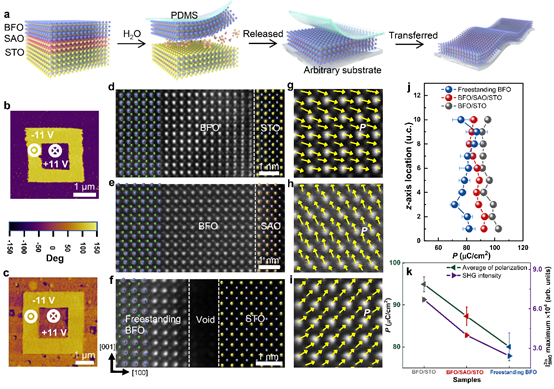A new method for exploring the magnetoelectric coupling effect of low-dimensional materials
2023/04/28
Recently, assistant research scientist Jiesu Wang from Low-dimensional Quantum Materials Group, together with her collaborators have made a new progress in the research of magnetoelectric coupling of multiferroic thin films, providing new ideas and methods for exploring the magnetoelectric coupling effect of low-dimensional materials. This work was published on Nature Communications on April 20, 2023, entitled as "Magnetoelectric coupling in multiferroics probed by optical second harmonic generation".
The coupling of electric and magnetic order in low-dimensional materials is of great significance for future development of low-dimensional multiferroics theory and magnetic-based information storage and manipulation. However, due to the instability and fragility of low-dimensional materials, as well as freestanding films, traditional detection methods can hardly characterize their physical properties effectively and nondestructively, making the characterization and regulation of the electric and magnetic interactions extremely challenging.
Assistant research scientist Jiesu Wang and her collaborators used the wide-temperature range optical second harmonic generation (SHG) technique with external magnetic field to study the magnetoelectric coupling effect in multi-ferroic BiFeO3 films. They systematically characterized the evolution of ferroelectric and antiferromagnetic orders in BiFeO3 films with different stresses regulated by external magnetic field and temperature. The researchers defined an optical magnetoelectric-coupling constant, denoting the ability of controlling light-induced nonlinear polarization by the magnetic field. They found that the magnetoelectric coupling was suppressed by strain releasing, as well as the antiferromagnetic and ferroelectric orders (Figure 1-3). The researchers also found that the optical magnetoelectric coupling in freestanding BiFeO3 films has the same order of magnitude at low temperatures of 10 K and room temperature of 300 K, indicating the robustness against thermal fluctuation and its great potential in applications of flexible multifunctional devices. The first-order phase transition with the Néel temperature of 618 K in BiFeO3 films and an ~7 times enlargement of saturate magnetization moment in freestanding BiFeO3 were also observed, and the later was mainly attributed to the variation in the Dzyaloshinskii-Moriya interaction.

Figure 1. Preparation and ferroelectricity characterizations of freestanding BiFeO3 films.

Figure 2. SHG patterns of epitaxial BiFeO3 films regulated by wide temperature range and external magnetic field.

Figure 3. M-H results and the variation of SHG intensity under external magnetic fields.
This work proved that the SHG technology with adjustable external fields (temperature, magnetic field, and electric field) is an effective probe for exploring physical properties such as magnetoelectric coupling, ferroelectric order (phase transition), and antiferromagnetic order (phase transition) in freestanding or two-dimensional multiferroic materials. This study lays a foundation for future characterization and research of magnetoelectric coupling effects in low-dimensional materials.
After nearly 3 years of construction and improvement, the multifunctional optical characterization laboratory of the low-dimensional quantum materials team can currently perform SHG characterizations including room temperature far-field transmission/reflection, room temperature micro-SHG/fluorescence characterization, and multi-field regulation (1.7 K ~300 K, -7 T~7 T) reflective SHG characterization, etc., providing a research platform for the physical property characterization and precise regulation of low-dimensional materials.
Jiesu Wang (BAQIS), Shuai Xu and Pan Chen (IOP CAS) are the co-first authors of the above work and Professor Kuijuan Jin (IOP CAS) is the corresponding author. This work was supported by the National Key Basic Research Program of China, National Natural Science Foundation of China, Beijing Natural Science Foundation and other projects.
Link of the publication: https://doi.org/10.1038/s41467-023-38055-x
 中文
中文 Email
Email QCloud
QCloud Log in
Log in
